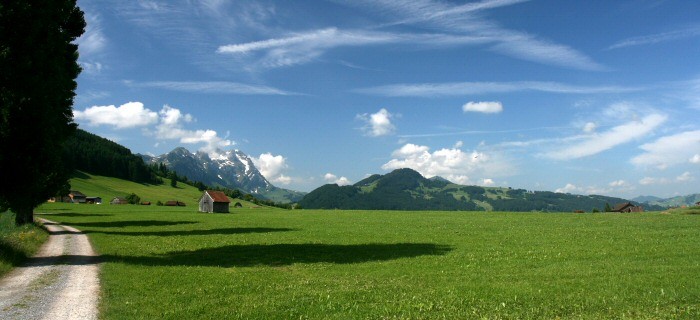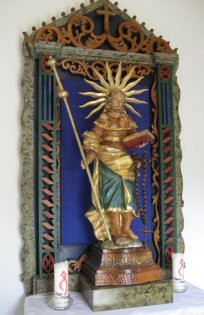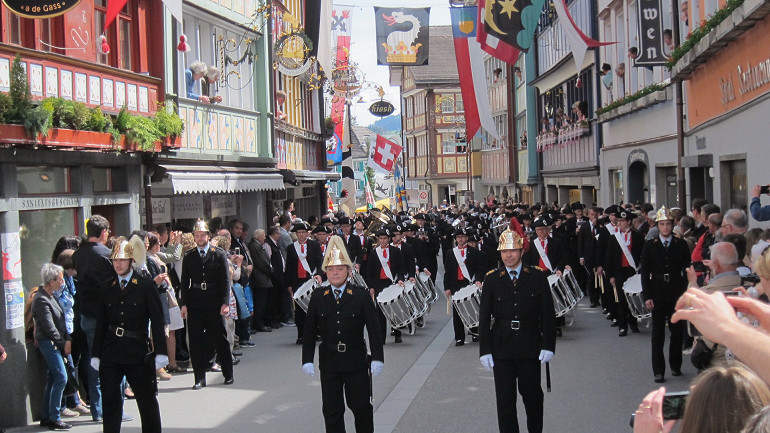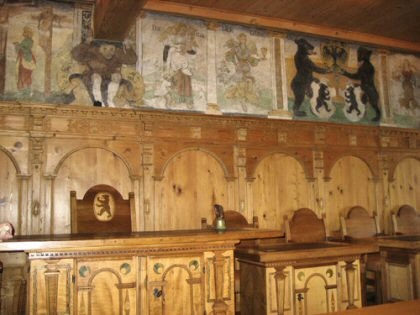On May 1, 2008, the ceremonial opening and blessing of the Appenzellerweg, the connecting section between the Austrian and Swiss Jakobsweg, took place here in front of the castle-like pilgrimage church, the Basilica of Our Lady on the Liebfrauenberg in Rankweil. On May 2, 2008, when I arrived here with my fellow pilgrims Marianne and Otto, the large marquee was still standing. A friendly woman pressed the brochure "Spiritual Hiking on the Way of St. James Landeck - Einsiedeln" into our hands (published by the Association Regional Development Vorarlberg - you can also download it as PDF - new edition 2013
But also at www.jakobsweg.ch (under Wegleitung) a guide has been published for download. In the Swiss 1:25000 National Map of Appenzell, as of 2007 edition, the path is marked. The trail is also marked as a national route at www.wanderland.ch.
Already in the 8th century a first church was built here. The statue of the Virgin Mary and a silver Byzantine cross are particularly venerated. The Fridolin chapel with the Fridolin stone dates back to 1690. To this day, people trust that a prayer on the Fridolin Stone will relieve rheumatism and other pains.
The church has been rebuilt several times and most recently completely restored since 2005. For the opening of the Jakobsweg Brückenschlag it shone in festive splendor. Because 2008 was a jubilee year.
500 years of the new basilica, 350 years of the Chapel of Grace, 250 years of the Altar of Grace.
This is the miraculous statue venerated in the sanctuary (Chapel of Grace). The baby Jesus is holding a nut in his hand. - Is this a clue for pilgrims - the path a crack?
Looking at it this way, we took bus 61 for the first part of the path leading out of Rankweil on a lot of asphalt. May St. James forgive us.
In the process, we drove past the Anna Chapel. I visited it on another occasion.
This is what the interior of the Anna Chapel looks like.

This picture of St. Anthony caught my eye. A certain similarity with the Mariahilfbild by Lucas Cranach is not to deny him.
After all the many Mariahilf pictures I have seen from Vienna to here, this one makes you think that it is actually not Mary who helps, but the little baby Jesus.
At Meinigen, the trail crosses the border at the Rhine. The Swiss part of the Appenzellerweg is signposted with "44" and here is also its lowest point with 430 m. That means: from now on it's uphill.
On the other side of the border, you pass the ruins of Blatten Castle. The castle from the 13th century served the Abbey of St. Gallen as a bailiwick and to secure its border area against the Counts of Montfort. It was destroyed during the Napoleonic Wars.
Very romantic, but a little dangerous because of the road, is the ascent through the Hirschensprung. The official guide also leads around the outside.
Soon we reach the village of Freienbach, a place of pilgrimage already known in the 17th century. Instead of the old chapel, there is now a modern church.
It houses a statue of the Madonna from the 17th century and some old votive tablets.
Further up at the Wogalp (880m) there is already a quite beautiful view of the Rhine valley.
From the Neuenalp (993m) you can see as far as Lake Constance.
At the chapel "Maria Bildstein" the highest point (1016m) is reached.
Soon (after about ½ hour) we are in Eggerstanden. On wonderful meadow paths, accompanied by the snow-covered Säntis, we go slightly downhill to Appenzell. The Säntis is with 2'502 m the highest mountain in the Alpstein.

Above Eggerstanden, on the so-called Langenegg (in hiking direction Appenzell on the right side of the valley) there is a small chapel with an image of Mary Help of Christians, which I visited on another occasion.
The chapel of St. Jakob auf der Halten originally stood in the middle of the Alte Eggerstanderstrasse, but had to give way to traffic and was moved to the north. The large stone block nearby is said to have come from the Rhine glacier.

At the small altar stands this baroque statue of St. James from the end of the 17th century..
1 ½ hours later (from Eggerstanden) we are at the outskirts of Appenzell and cross the Sitter.
In Appenzell - in the picture the main street - we spent the night.
Things are very different here at a Landsgemeinde assembly

The Appenzell town hall from the 16th century. The facade paintings are more recent (1928).

The interior of the town hall consists of two council halls on the second floor: the larger one has been restored to its original beauty of 1567.
